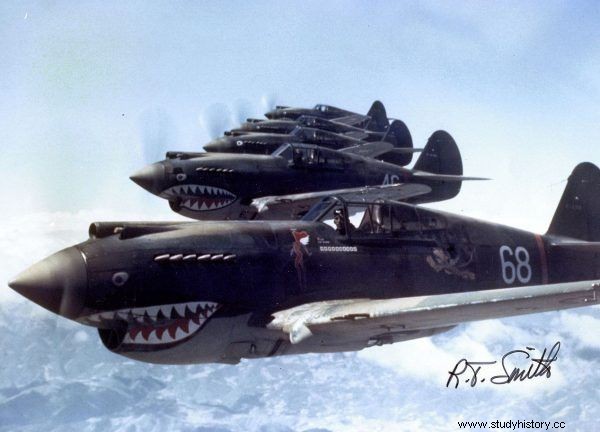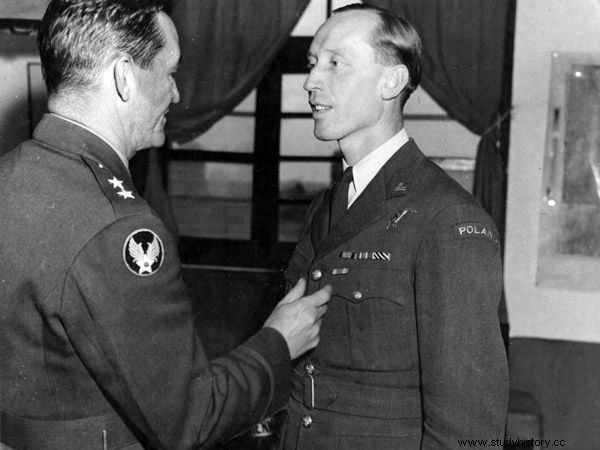Japan was the only country to which Poland officially declared war in the 20th century. Only one Polish soldier was directly involved in the military operations against it. But he could fight for the entire squadron.
The famous Polish fighter pilot, Major Witold Urbanowicz, became an air attaché in Washington in the second half of 1942. There, he met officially and informally with leading representatives of the American political and military establishment. He accompanied General Sikorski during a meeting with President Roosevelt and learned the secrets of the organization and equipment of the American Air Force. He then made two important decisions:he got married, and then he volunteered to China to fight the Japanese.
Invitation to the Middle Kingdom
Urbanowicz accepted the invitation sent to him by General Claire Chennault. Commander of the 14th Air Army operating in that area. Chennault, a talented and charismatic officer, was the founder of a voluntary American fighter unit fighting alongside the Chinese leader Chiang Kai-shek against the Japanese empire. His pilots quickly became famous for their drunken pranks and lack of discipline, as well as for their excellent efficiency.

General Claire Chennault. It was at his personal invitation that Witold Urbanowicz joined the Flying Tigers (source:public domain).
The main aircraft in the Yankee armament was the P-40 Warhawk. They had to face the formidable Mitsubishi A6M Zero on this not very modern machine at that time. With inferior equipment at their disposal, the Americans developed a special tactic consisting in an unexpected attack in a diving flight. It brought them a lot of success. The Warhawks are distinguished by the open jaws of a shark painted on the engine cover and a winged tiger under the pilot's cockpit. This is where the name Flying Tigers came from.
How do I recognize a Japanese?
Urbanowicz was initially stationed at the airport in Kunming, where he underwent appropriate acclimatization. He also learned many, inherently necessary things in battle. Years later, in his memoirs, he wrote:
I read a very valuable tip in the instructions for US soldiers; that a Japanese can be easily distinguished from a Chinese because he has a big toe that protrudes.
Of course, this turned out to be nonsense. However, he was surprised by the uncompromising attitude of Japanese pilots in air battles. Urbanowicz quickly gained respect for their courage, fanaticism and tenacity. As he summed it up: there were really different rules of fighting . Nevertheless, the Polish pilot proved with his achievements that contempt for death cannot replace experience and training.
First Zero down
On October 14, 1943, at 10:30 am, an American squadron with a Pole in its squad set off from the Kunmimg airport. Their task was to provoke take-off and bring Japanese fighters based in Haifong on their way. This was to enable their own bombers to bomb the local airport and enemy ships in the Gulf of Tonkin. The Japanese did buy a trick and the American Warhawks were attacked by Zero fighters.
One of the Japanese planes stuck to Urbanowicz's machine. The Pole, despite skillful maneuvers, could not throw him off his tail in no way. Here, however, his hard character, experience and nerves of steel made themselves felt. Urbanowicz decided to get the Japanese after he fired all his ammunition at him!

Urbanowicz - as well as other Flying Tigers - fought the Japanese at the controls of the already outdated Curtiss P-40 Warhawk fighters (photo R.T. Smith; public domain license).
As he intended, he did so. The sky samurai, although he used his missiles, did not give up and tried to ram the Polish fighter. Urbanowicz avoided a collision at the last moment, and then he raced Warhawk in a steep dive behind the receding Zer.
The Polish ace of fighter is not used to wasting ammunition in such situations. The Browning missiles of his P-40 torn the fuselage of the enemy plane. The Japanese pilot made a parachute jump and landed in the waters of the Gulf of Tonkin, where he was caught by sharks.
This article has more than one page. Please select another one below to continue reading.
Victory in pajamas and without firing a shot
His next victory over Mitsubishi Zero Urbanowicz was achieved in quite exceptional circumstances. One morning, just before dawn, a Pole was unceremoniously torn from bed by an operating officer. It was to fly in tandem with the American pilot, Major Texas, for reconnaissance in the Hong Kong and Canton area.
Our brave aviator, in an uncharacteristic moment of laziness, put on a flight suit… right over his pajamas! It was a hasty decision, as the flight was going to be difficult:long and at high altitude over the mountains, where the temperature is low.
Additionally, the arrival at the destination took place in very difficult weather conditions. The fighters had to fight their way through a powerful storm, and Urbanowicz was shivering with cold in his silk pajamas. Already over Hong Kong, the Warhawks were intercepted by two zeros. The Pole got into a fight with a particularly brave Japanese pilot. The enemy several times approached him from the distance of the shot, but our ace with skillful maneuvers always eluded him.
Finally, when Urbanowicz was in a convenient shooting position and pressed the trigger, it turned out that his machine guns jammed! Even so, with the appearance of an attack, he ran Zero ahead of him. The Japanese pilot panicked, performing desperate stunts with the P-40 on its tail. At some point: collides with the ground at high speed, makes a grinder, lights up (quoted by Witold Urbanowicz "As. Memories of the legendary commander of the 303 squadron"). On the way back to the base, the defenseless Pole was attacked again by four enemy fighters. Luckily he managed to get away.

Witold Urbanowicz was awarded the American Air Medal for his service in China. The photo shows the moment of awarding Urbanowicz with the decoration by general Claire Chennault (source:public domain)
As he claimed years later, during the fighting in the Far East, his account of victories increased by as many as 11 Japanese planes. He knocked down 6 enemy machines in the air, and destroyed another 5 at the airfields ("As. Memories of the legendary commander of Squadron 303"). Officially, however, he was only credited with two kills.
At least one American pilot owes him a life. Major Elmer Richardson came out alive after a Pole shot down two Imperial fighters attacking him. Urbanowicz received official thanks for this from the Commander-in-Chief of the US Air Force, General Henry Hap Arnold. The Polish ace fighter returned to Europe at the beginning of 1944. For his services in the Far East, he was decorated with the American order of the Air Medal and the Chinese Air Cross.
